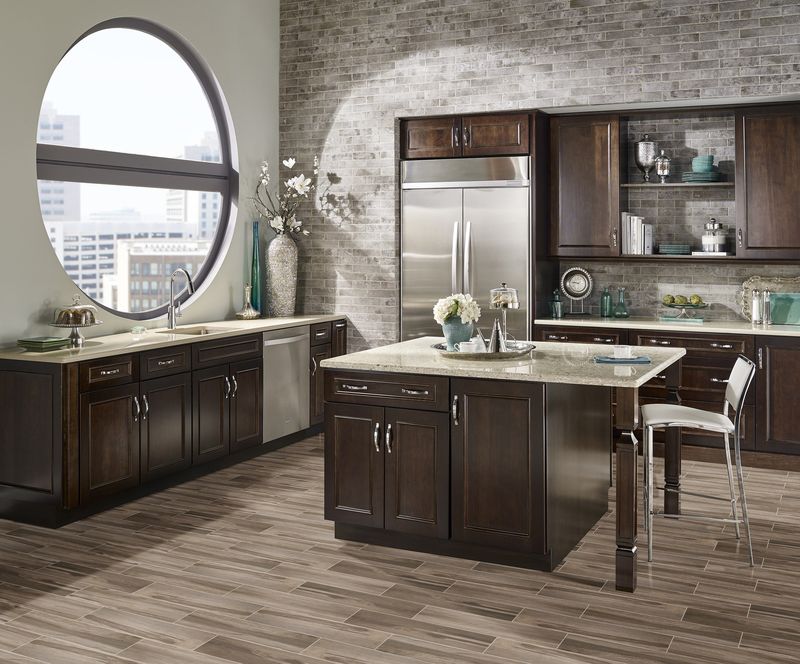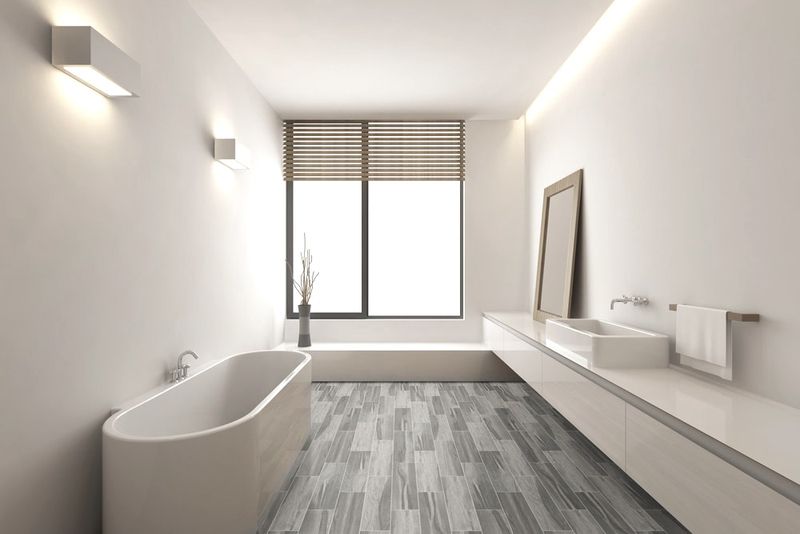How to Correctly Trowel Mortar When Installing Tile

Brook Beige SKU: 15221426
Ceramic tile floors are durable, beautiful and easy to maintain. That makes them a go-to choice for high-traffic residential spaces like entry areas, foyers, mudrooms and family areas. Ceramic tile, while not quite as impervious to water as porcelain tile, is also a smart choice in spaces where some water is present like in powder rooms and kitchens.
Installing ceramic tile flooring can be a big job. One aspect of the job that even some pros struggle with is how to properly trowel mortar when installing ceramic tile. Use this guide to learn the process and avoid the pitfalls of a poor installation process.
Understand the Mortar Types and Their Functions
Traditional thin set mortar and more modern large and heavy tile (LHT) mortar serve a few basic functions when installing new ceramic tile flooring. Here’s what these mortar types really do:
• Mortar bonds your tile to the substrate below
• They bond to the back of the tile to make a secure connection
• Mortar provides adequate support for your tile
If you’ve chosen the correct mortar type – either thin set or LHT mortar – you’re at least part of the way to a successful install whether you’re putting in classic ceramic or specialty varieties designed to look like natural wood. For a truly sound installation though, you need properly troweled mortar to bear the brunt of the load from foot traffic and heavy items like furniture.
Choose the Right Trowel Type and Notch Size
Picking the right trowel type and an appropriate notch size is essential. Here are a few tips to help pick the right tool for the job:
• Avoid using a V-shaped trowel in most cases. A V-shaped trowel may make it so that you don’t get adequate coverage to support the tile.
• Don’t use a trowel with a notch that’s too small for even, all-over coverage. A trowel with a notch that’s too small will have you feeling like you’re working in layers or painting a large surface area with mortar to get even coverage.
Work to the Layout Line
One common problem you’ll see with novice tile work is that the installer often stops applying the mortar too early. For a sound installation, you need to spread the mortar completely to the layout line without stopping.
Many installers stop at the chalk line to avoid unsightly mortar squeeze that will make more work for them down the road. Unfortunately, this can result in a major failure, particularly in areas exposed to high pressure loads like high heel points or piano legs.
Working all the way to the mortar line and cleaning up your work appropriately can help you avoid a major failure down the road. Once these failures happen, you’ll likely need to begin much of the work again and replace at least some of your already installed ceramic tile.
Work in a Straight Line
Troweling mortar in one direction, typically working from left to right like you’re reading a book will provide the best overall coverage. Once you’ve applied your mortar, placing the tile and moving it back forth using a perpendicular motion will help properly set it in place. This perpendicular movement is especially important since it helps to evenly spread out the mortar on the back of tile, leaving few gaps or voids. That means better overall support for your whole tile.
While this may seem oddly specific, there are a few good reasons for working this way. Namely, trowel ridges that are straight lines are considerably easier to cover and collapse, making a firm, secure connection between mortar and tile. This quick, easy coverage also helps remove and maximize coverage even further, giving you the ideal bond between your tile and the substrate beneath.
Here’s a quick step-by-step guide that can help you understand this process:
1. Key in a coat of mortar into the substrate. This helps create a good mechanical bond with the flat side of the trowel you’re working with.
2. Add more mortar to the substrate while working the mortar into clean straight lines.
3. Use trowel ridges that go in the same direction as the shorter side of your tile when working with rectangular planks. This improves air release and enhances your bond.
4. Don’t leave voids along chalk lines to avoid mortar squeeze. Work up to the line to create a secure bond between tile and substrate.
5. Choose a trowel that will offer you continuous 3/32″ coverage while you’re working. Use a deeper trowel for larger tiles.

Nova White SKU: 15221429
Avoid Common Mortar Mistakes
Applying mortar correctly can help you avoid serious damage and tile replacement down the road. Here are some common mistakes to avoid when working with quality brands like Cabot ceramic tile:
• Don’t swirl the mortar. Swirling mortar can keep create a loose bond between the substrate and your tile. This may result in tile damage like cracks or complete failure.
• Don’t spot bond with mortar. Spot bonding with mortar can create pressure-related failures down the road. This procedure is not recommended for installing any type of flooring tile.
Back Butter Like a Pro
Large format tiles specially can benefit from the process known as back buttering. Here’s how you can do that:
• Use the flat side of your trowel to get an even mortar coat without gaps present.
• Set the tile firm in place after keying in. Move the tile back and forth across the trowel ridges the same distance as the width of the trowel notch. Work only in one direction. Remember that more back and forth motion is needed when you’re working with a larger trowel.
• Remove a tile and check for proper coverage occasionally during your installation. Make sure the ridges are properly collapsed into valleys and your substrate and tile are both properly covered with mortar.

Ready to take on a new tile installation or learn more about the different ceramic tile for floors available at BuildDirect today? Reach out to one of our trained representatives now. You can also visit the Ceramic Tile Education Foundation (CTEF) to learn more about their upcoming certified tile installer test that will take place in February in Florida. Many thanks to Scott Carothers from CTEF for providing the content that was the foundation of this guide.
